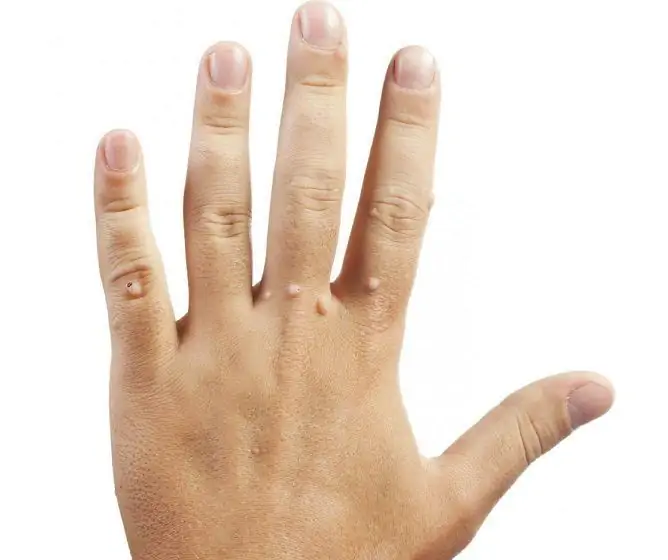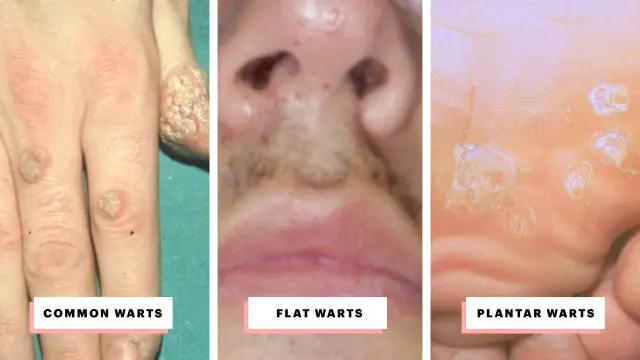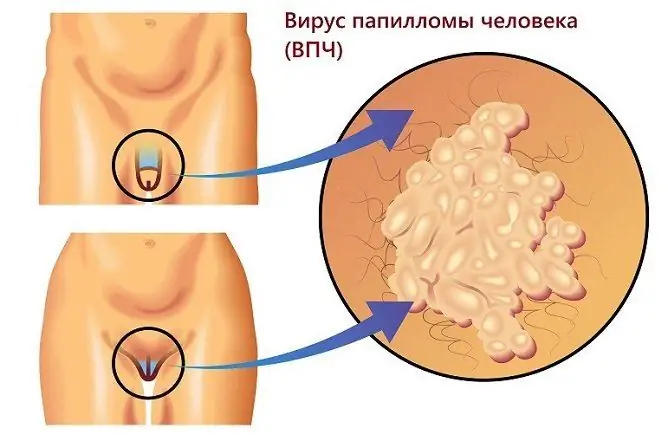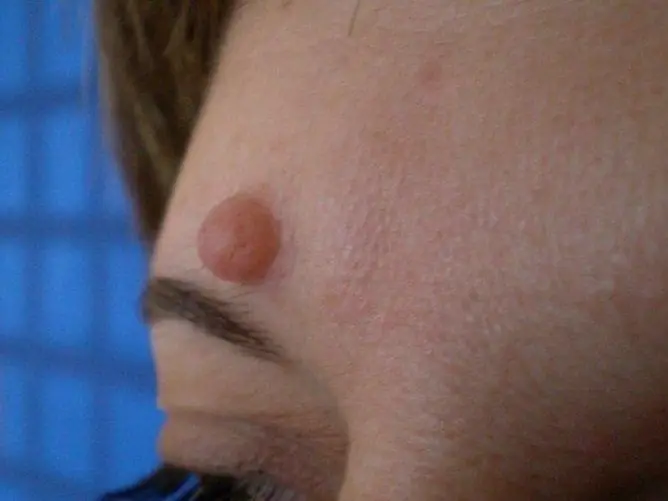- Author Rachel Wainwright [email protected].
- Public 2023-12-15 07:39.
- Last modified 2025-11-02 20:14.
Vulgar warts
The content of the article:
- The reasons
- Symptoms
- Diagnostics
- Treatment of vulgar warts
- Home treatment
- Forecast
- Prevention
- Video
Vulgar warts (simple, common) - a viral disease, which is characterized by the appearance on the skin of a small epidermal benign neoplasm of a rounded shape. It is widely used. In the general structure of dermatological diseases in adults, it accounts for 45%, and in children and adolescents - 60%.

Vulgar or simple warts can affect people of any age, but are more common in children
The reasons
The cause of the formation of vulgar warts is infection of the body with the human papillomavirus (HPV). The main routes of infection are:
- contact - in close contact with a sick person or a virus carrier, as well as their personal belongings;
- autoinocular (self-infection) - the transfer of infection from affected areas of the skin to healthy ones (for example, in children who bite their nails).
The predisposing factors for the onset of the disease are:
- violation of personal hygiene rules;
- visiting public pools, baths, saunas;
- animal care, carcass cutting.
The human papillomavirus enters the body through microtrauma of the skin. For a long time, it is in the cells of the basal layer of the epithelium and does not manifest itself clinically. With a decrease in immunity due to the influence of various negative factors (infectious diseases, hypothermia, severe stress), the virus is activated, as a result of which characteristic growths appear on the skin.
In about 90% of patients, spontaneous recovery occurs within a year from the moment of infection (provided there is no further self-infection). In the remaining 10%, the disease takes on a chronic course with periods of remission and exacerbations. Exacerbations occur against the background of a decrease in the general defenses of the body. During them, the infection spreads and new formations appear on the skin.
Symptoms
Vulgar warts are usually found on the skin of the fingers and the back of the hands. Much less often, the place of their localization is the skin of the palms, feet or mucous membranes. In children who are prone to nail biting, growths are located around the nail plate.
The size of epidermal neoplasms ranges from a few mm to 1.5 cm. In most, the formations are flesh-colored, but sometimes they can be yellowish or pink. Long-standing warts gradually darken.
Simple warts are single and multiple (papillomatosis). In the latter case, one formation with a larger size is always distinguished. It's called the maternal wart.
Without treatment, the disease usually lasts 6-12 months. During this time, the formation of antibodies to HPV occurs in the human body and self-healing occurs. In patients with reduced immunity, rashes persist for a long time and new ones periodically appear.
Diagnostics
Diagnosis of the disease is usually not difficult and is carried out by the presence of characteristic growths on the skin. If necessary, the doctor may prescribe a PCR test for the presence of human papillomavirus.
Vulgar warts should be differentiated from a number of other dermatological diseases:
- warty form of skin tuberculosis;
- lichen planus;
- warty basalioma;
- verrucous nevus;
- keratomas.
Special clinical atlases on dermatology provide some assistance in conducting differential diagnostics. They contain numerous photos showing various types of rashes and neoplasms that occur in skin diseases.
After removal of the epidermal neoplasm, the resulting tissue must be sent to the laboratory for histological examination.
Treatment of vulgar warts
Given that in over 90% of cases, simple warts tend to self-heal, therapy is usually not required. Patients are advised only to lubricate the skin around the neoplasms with antiviral ointments to prevent further spread of the infection.
The main indications for prescribing treatment are:
- multiple rashes;
- weakened immunity (chronic infectious or somatic diseases, leukemia, malignant neoplasms, HIV infection);
- discomfort and pain during work;
- cosmetic defect.
The procedure for removing wart formations is performed on an outpatient basis using various methods presented in the table:
| Method | Description |
| Chemical moxibustion | Skin growth is lubricated with agents containing acids or alkalis. They cause coagulation of cellular proteins, which causes the death of the tissue of formation. A small scab remains at the site of the wart, which disappears after 7-10 days. |
| Cryodestruction | The neoplasm is deeply frozen with liquid nitrogen. After the wound has healed, no scar or pigmentation remains in its place. |
| Electrocoagulation | An electrode in the form of a thin loop is cut off the formation and the bleeding vessels are cauterized. |
| Radio waves | The build-up is burned out using high-power radio waves. |
| Laser radiation |
The laser beam burns out the epidermal formation, and in its place remains a small scab formed by a clot of clotted blood. It disappears after about a week. Clean and healthy skin remains in its place. |
| Surgical removal | With multiple warts, the affected area of the skin is excised. Then the wound is sutured with a cosmetic subcutaneous suture. After healing, a thin, barely noticeable scar remains at the surgical site. |
To prevent recurrence of the disease, patients are prescribed antiviral and immunostimulating therapy. In particular, they can be prescribed (only a few names of drugs are given for informational purposes):
- Oxolinic ointment;
- Panavir;
- multivitamin preparations;
- Immunal;
- Polyoxidonium.

Oxolinic ointment is used as an additional treatment for vulgar warts
Home treatment
You should not try to independently try to treat vulgar warts. Self-medication poses a huge risk to human health, associated with a high likelihood of developing complications.
Traditional medicine is recommended to lubricate their surface with celandine juice, vinegar essence or alcohol tincture of iodine in order to remove skin growths. However, prolonged use of these agents leads to a chemical burn of the skin and trauma to the warts, which can provoke their malignancy, i.e., degeneration into a malignant tumor - cancer.
When epidermal neoplasms appear, you should consult a dermatologist and carry out treatment, carefully following all the recommendations of a specialist.
Forecast
The forecast is favorable. The disease is completely cured in 90% of cases. In the rest of the patients, periodic formation of new skin growths is observed, despite full-fledged timely treatment.
Long-term epidermal neoplasms, as well as those undergoing frequent trauma, can become malignant.
Prevention
To prevent infection with papillomavirus, it is important to carefully observe personal hygiene measures, especially when visiting public pools and baths, as well as when in contact with animals.
Video
We offer for viewing a video on the topic of the article.

Elena Minkina Doctor anesthesiologist-resuscitator About the author
Education: graduated from the Tashkent State Medical Institute, specializing in general medicine in 1991. Repeatedly passed refresher courses.
Work experience: anesthesiologist-resuscitator of the city maternity complex, resuscitator of the hemodialysis department.
Found a mistake in the text? Select it and press Ctrl + Enter.






